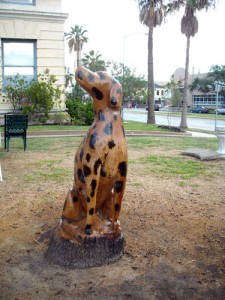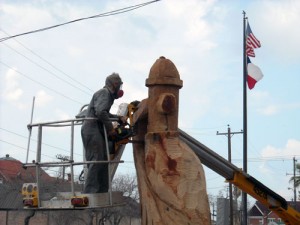Tree art restores hope to recovering community

The dalmation carved by sculptor James Phillips from one of the many dead oak trees in Galveston. This sculpture, as well as Phillips’ fire hydrant carving, are located next to Galveston’s city hall building.
Christine Crump
The Signal Staff
Hurricane Ike tore through Galveston Sept. 13, 2008, with a storm surge of 15 feet covering the island with petroleum laced salt water. Ultimately, the salt water from the storm’s surge left thousands of trees dead, including the 100-year-old live oaks that lined Broadway Boulevard.
On the city of Galveston’s Web site, there has been an estimated 11,000 trees that have died as a result of Ike. Of those trees, 3,400 have already been removed from public right of ways.
The Galveston Island Tree Conservancy started a committee because they did not want to see the dead trees end up in a landfill. Instead, they are using the wood to recycle, reuse and create works of art.
Two dead oak trees in front of Galveston’s City Hall were selected to create a work of public art, instead of cutting them down and sending them to the landfill. The Galveston Island Tree Conservancy chose James “Jimmy” Phillips to create a dalmatian and fire hydrant sculpture out of the trees.
“At first I was hesitant to agree to the sculptures,” said City Manager Steve LeBlanc. “But, the members of the Tree Committee and the community at large convinced me it was a worthwhile endeavor. I agreed to support the carvings and I really think they are spectacular. Mr. Phillips is quite an artist.”

James Phillips saws away as he sculpts a fire hydrant out of an oak tree that died as a result of Hurricane Ike. This sculpture is located next to City Hall in Galveston.
Phillips is a hobbyist carver who started carving trees four years ago, after cutting down a tree in his front yard.
“I was doodling with a chainsaw and someone liked what I did,” Phillips said.
Donna Leibbert, a member of the Galveston Island Tree Conservancy, got a call from Phillips saying he would donate his time to do the sculptures.
“He came down with a little clay statuette of a dalmatian,” Leibbert said, “and I went ‘Bingo, you’re my guy!’ ”
Leibbert said a donor offered to cover all of Phillips’ expenses.
“The dalmatian and the fire hydrant were requested by Donna and the tree committee,” Phillips said. “It was a tribute to the fire department and their inability to have a dalmatian on site.”
Assistant Fire Chief Jeff Smith said that there cannot be a dalmatian on site because “It’s more for the safety of the puppy and the liability.”
Ike was a devastating storm that left many people overwhelmed with everything that was lost. The city of Galveston needed something to lift the spirits of everyone on the island.
“The storm’s surge really devastated our island,” LeBlanc said, “We were cautiously optimistic that our trees would survive, but so many of our live oaks eventually succumbed to the salt and stress. Having an artist create something positive from our dead trees helps our community heal.”
Giving hope to a community that lost over 80 percent of its trees from Ike is an essential.
“It’s just, can we save the trees, can we have something to smile at, can we bring some joy to somebody, can we keep them just a little while longer rather than grind them up in a landfill?” Leibbert said.
Phillips has a few more tree sculpting projects coming up, including three private commissions in Galveston and one in Houston.
LeBlanc said four more trees have been identified to be carved by Phillips in Galveston. There will be one tree at Adoue Park, Wright-Cuney Recreation Center grounds, Jones Park, and Schreiber Park carved into sculptures.
Other examples of Phillips’ work is on display at the Rene Wiley Studio and Gallery on Postoffice Street in Galveston.
The sculptures of the dalmatian and the fire hydrant are located next to City Hall at 823 Rosenberg in Galveston, Texas.


Comments are closed, but trackbacks and pingbacks are open.